Below, only some elements related to the safety and use of the Seacraft batteries are presented:
- Please read the manual as it contains important precautions, warnings and information.
It is essential that it is carefully and fully read before using the battery. - The battery may only be used by persons with appropriate training in this field. It is strongly forbidden to use the battery without obtaining special qualifications for diving with a scooter.
- Using the battery for purposes other than those specified in this manual or in violation of the rules set out in this manual may result in serious personal injury or even death.
- When using a Seacraft battery different than the original battery built in the scooter, it is necessary to read the enclosed leaflet and instructions for use of the said battery.
- Never use or carry a battery showing signs of mechanical damage.
- Always check the level of the battery before entering the water.
- Use a battery charger in a manner inconsistent with the instructions in the user manual, in particular in conditions of high humidity or when the power cord is damaged may present a risk to the user’s health of life. Do not touch any part of scooter ‘s charger with wet hands.
- It is forbidden for children and adolescents under 18 years of age to use the battery, or to leave the device unattended.
- Before transporting the battery, ensure it is packed in a way that prevents it from damage during shipping. Remember to use the provided blind plugs, to secure the segment’s electrical connectors. For transporting the battery segments, it is recommended to use the optional Seacraft transport bag.
Battery segment specifications
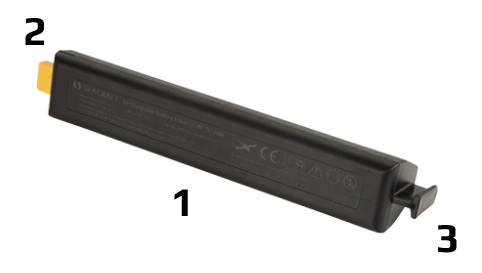
Segment features
1 – Sealed segment body with notes and usage information
2 – Segment connection to plug into the battery housing
3 – Segment handle for pushing in/pulling out the segment
Segment specifications
| Type | Li-Ion |
| Capacity | 97 Wh |
| Max. voltage | 37,5 V |
| Length | 250 mm |
| Weight | 0,54 kg |
Removing the battery segments
Proceed as follows to install the battery segments:
- Open the scooter (→ Opening the scooter).
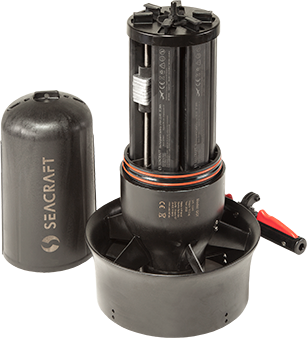
- Loosen and remove the locking nut of the battery segment holding ring, and keep it in a clean area.
- Remove the battery segment holding ring, and keep it in a clean area.
- One after the other, remove the battery segments, and protect their connectors with one of the supplied protection caps.
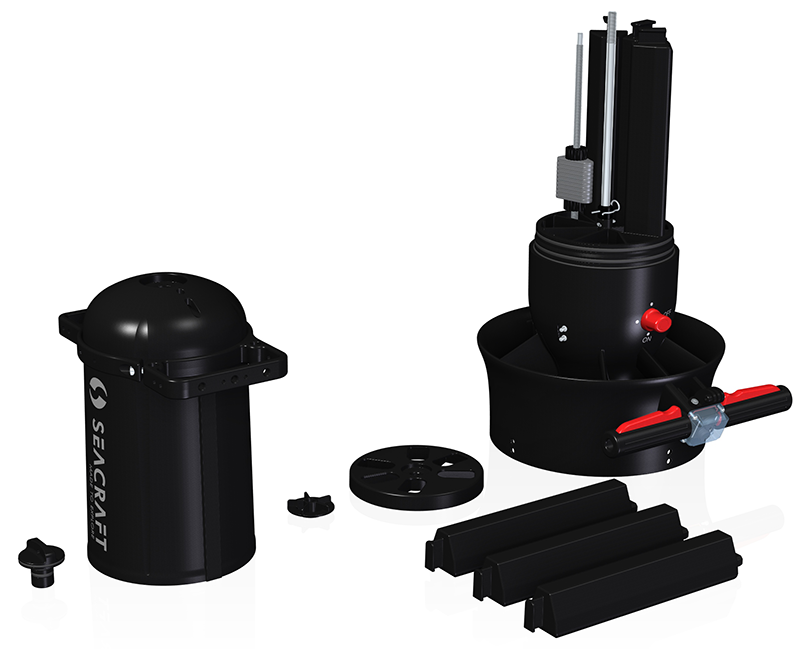
- Place the battery segments in the provided Seacraft transport bag.
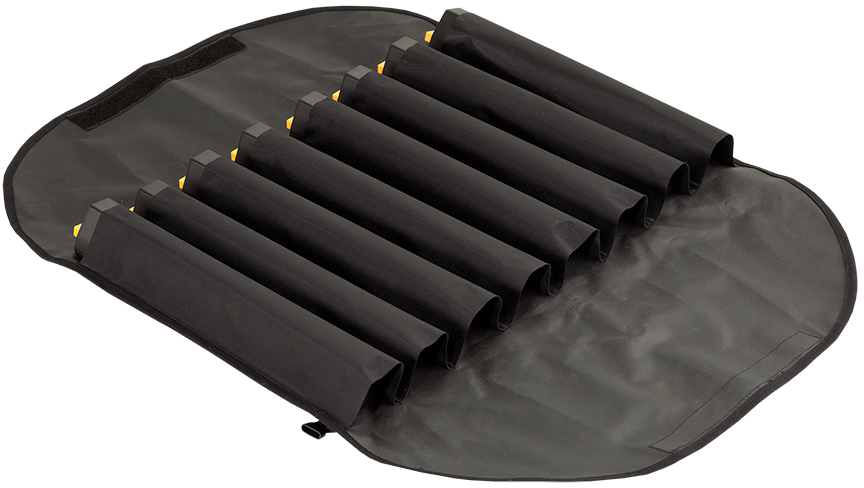
- Install the battery holding ring again onto the scooter‘s center rod, and secure it with the locking nut.
- Close the scooter (→ Closing the scooter).
Installing the battery segments
Proceed as follows to install the battery segments:
- Open the scooter (→ Opening the scooter).
- Loosen and remove the locking nut of the battery segment holding ring, and keep it in a clean area.
- Remove the battery segment holding ring, and keep it in a clean area.
- Remove the safety disconnector.
If you do not remove the safety disconnector before installing the battery segments, your scooter might only be switched on after connecting the charger to it. - One after the other, remove the protection caps from the battery segments, and vertically lower down the battery segment to one of the free connection ports on the scooter’s corpus.
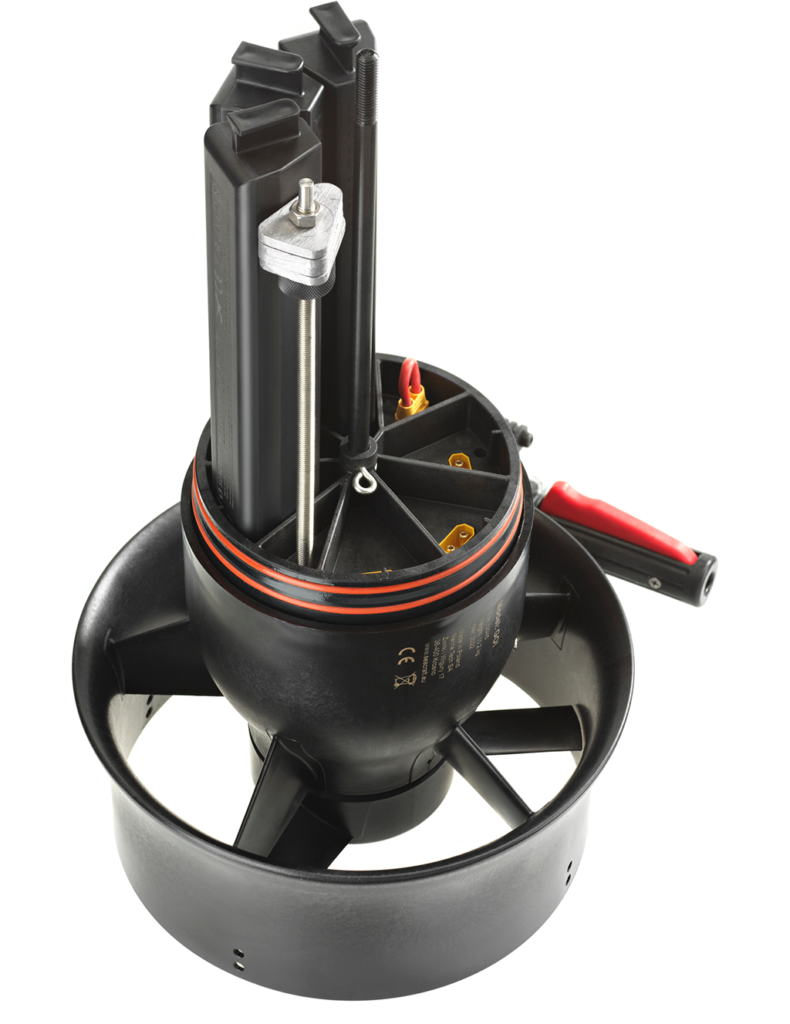
- Install the safety disconnector.
Without the safety disconnector, the scooter cannot be switched on. - Install the battery holding ring again onto the scooter‘s center rod and over the segment handles, and secure it with the locking nut.
- Connect the safety disconnector, in order to link the battery segments with the scooter’s control system and with the engine.
- Close the scooter (→ Closing the scooter).
Charging the battery
To prepare the charger, please read the separate charger manual carefully.
Then, proceed as follows:
- Connect the charger to a working electrical outlet.
- Make sure, that the 2 charging pins on the scooter’s body are dry and clean, in order to avoid damaging the scooter or the charger, when connecting the charging cable.
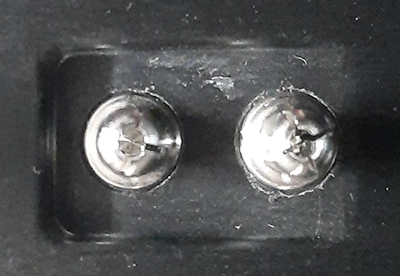
- Connect the charger to the scooter’s charging pins (the polarity does not matter).
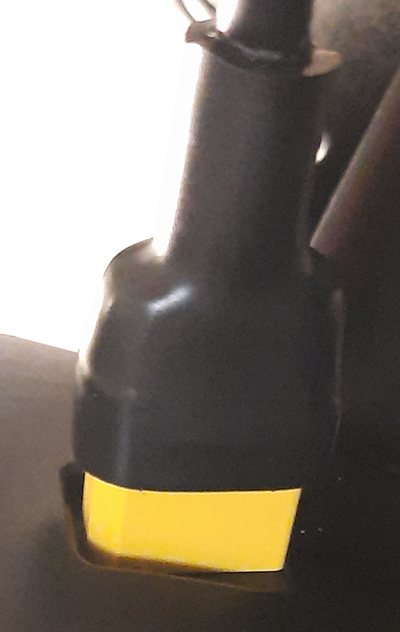
- The charging procedure begins, if the charger’s cooling fan is activated.
- The charging progress is displayed by the colored LEDs on the right scooter display side.
- If the scooter’s battery is sufficiently charged for your purposes, pull off the charger plug from the scooter’s charging pins.
What to observe with the modular battery
With a standard scooter battery, all of the cells are normally inextricably connected to each other. Thus, charging and using such a battery means, that all cells are charged and discharged evenly and at the same time.
Now, one feature of the Seacraft modular battery is the possibility to dismantle it, in order to transport the extracted segments as hand luggage (if the chosen carrier permits this).
But this feature reanders the user responsible for making sure, that all segments of a modular battery are charged and discharged evenly and at the same time.
While you may rest assured, that combining battery segments with different charging levels poses absolutely no risk or danger, this approach will confront you with the fact, that you will loose battery capacity temporarily. Therefore, when using a modular Seacraft battery, always remember the following:
Combining battery segments
If you combine battery segments form different sources (e.g. from different modular batteries or by adding new segments to an existing modular battery), it is recommended to assume, that these segments have a different charging level than the segments already in place.
Why is this important? Well, if the charging level of the battery segments differs by more than 0,5 V, the less-charged segments will be “blocked” and thus rendered inactive. This is a feature to protect the whole battery as a unit. An example:

You are using 4 segments, charged to 100 % and 2 segments charged to 50 % and 70 %.
Your scooter will now have 4/6 of its nominal power, since 2 segments are “blocked”.
When the 4 segments reach 70 % charging level, 5 segments will work together again.
When the 5 segments reach 50 % charging level, the modular battery will provide 6/6 of its nominal power again.
BUT: When you discharge the 4 segments only to e.g. 75 % and then charge the whole battery, the 2 blocked segments will stay blocked!
Checking the charging level of battery segments
As stated above, you need to be sure that the battery segments you combine in the battery hull provide a uniform charging level. To check the charging level, you may of course use a volt meter or (as a simple, but less precise approach while you are traveling) by the following method:
- Insert one battery segment at a time into the battery hull, and connect the modular battery to your Seacraft scooter.
- Switch on the scooter, and the battery indicator will show you the charging level of the inserted segment. If required, note the charging level.
- Switch off the scooter, disconnect the modular battery from the scooter, and remove the battery segment. Put the segment aside, and If required, place the note with the measured charging level with it.
- Repeat this procedure for the remaining battery segments.
Preparing the combined battery segments for use
In order to make sure, that all combined battery segments provide the same charging level, there is one procedure which will always work:
- Charge the scooter’s battery segments completely (to 100 %).
- Remove the scooter’s safety disconnector.
- Remove the charged battery segments, and install the remaining battery segments.
- Plug in the scooter’s safety disconnector.
- Charge the these battery segments completely (to 100 %).
- Remove the scooter’s safety disconnector.
- If required, fill up missing battery segments, with the previously charged battery segments.
- Plug in the scooter’s safety disconnector.
- Let the scooter remain unused for 24 h, so the battery segment voltages may equilibrate.
Then, close the scooter → Closing the scooter).
The battery “lifetime” in a Seacraft scooter is estimated at approx. 300-400 cycles and a period of 3-4 years. After that period, the battery will continue to work, however its capacity may be reduced due to natural battery capacity decrease. To check precisely the condition of your battery, contact your closest service point.
Usage patterns of the scooter and battery charging affect its durability.
Adherence to the manufacturer’s guidelines guarantee an extended battery life and the safete scooter use.
Among other things, the battery charging time depends on the following factors:
• Charger model
• Remaining charge
• Battery state
• Ambient temperature
Please see the Seacraft support website for more detailed information about the battery lifetime:
Transporting battery segments
If you plan to transport the battery segments separately from the scooter, remove the battery segments (see “Removing the battery segments” above).
It is recommended to use the optional Seacraft transport bag to keep all segments of one battery together.
If you are planning to fly with the battery segments, prepare for this, and print recommended documents from
In any case, make sure that the segments are protected against mechanical damage, direct sunlight and other detrimental influences.
Storing the battery segments
The battery segments should be stored in a cool, dry place; the optimum storage temperature of the battery is approx. 10 °C. Storage of the battery at temperatures above 30 °C significantly reduces the battery’s lifetime.
It is forbidden to store the battery segments in places exposed to direct sunlight, in heated, closed and unventilated spacer (e.g. vehicles) and near heating appliances.
In case you can foresee, that the battery segments will not be used for 6 months or longer:
Charge them to approx. 50 %; this is the optimum charge level, which means the life of the battery decreases slowly.
Dismantle the scooter by removing the housing cover (→ Opening the scooter) and removing the safety disconnector. Disconnecting the battery does not create problems with the scooter’s electronics.
In case the device is stored at high temperatures, under which the accelerated self-discharge is taking place, the user should check the battery level once a month, and in the case of discharge below 40 % recharge the battery segments to approx. 50 % of capacity.
It is recommended that the first use of the battery segments (after more than six months of inactivity) to perform a full cycle of charging – discharging – charging. This will allow the calibration of the measurement system and to determine the battery condition and charge level.
If the battery segments reach a voltage lower than the critical value, please contact the manufacturer or the scooter distributor to verify whether it is possible to restore their functionality.
The decrease in battery capacity over time is a natural feature of all batteries, including Li-Ion batteries. The user should keep in mind that over time battery capacity is getting lower, which means that the maximum swimming time with the scooter on a charged battery is reduced. When planning a diving trip with a scooter the user should take into account the wear and tear of the battery segments.
Transport restrictions
Transferring and carrying Li-Ion batteries of large dimensions using a mass transport is subject to regional and national legal regulations. As a rule restrictions in transport of these items are applicable only in the case of air transport. In the case of transport by land the aforementioned restrictions are not valid. Therefore, each time before sending packages containing the Seacraft scooter with battery segments installed, refer to local regulations for restrictions on the carriage of certain items or contact your carrier, distributor or the manufacturer of the scooter for detailed information on restrictions on transport of Li-Ion cells and batteries.
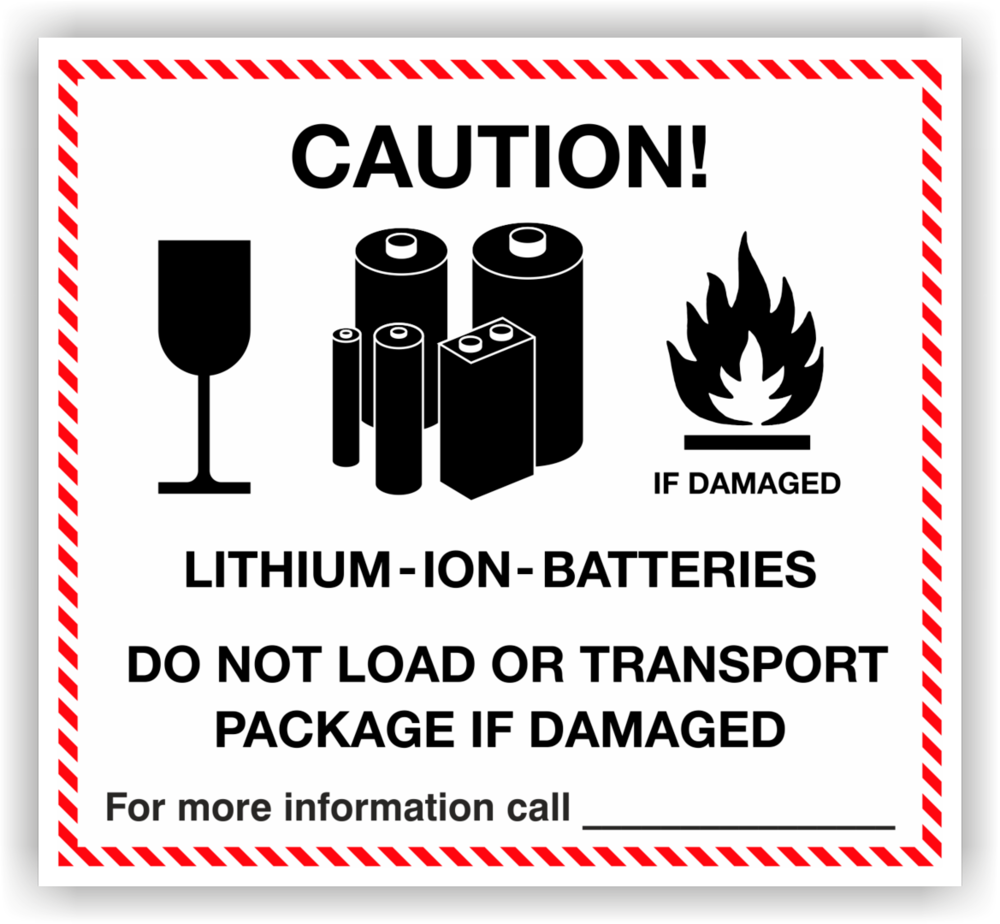 | During transportation, the battery segments must be protected against mechanical damage, particularly crushing. Damages of this type pose a fire risk. Never use or carry a battery segment showing signs of mechanical damage. |
Disposing of the battery segments
 | The battery segments are products, which after use become waste, hazardous to people, animals and the environment. It is prohibited to place used battery segments in containers for domestic waste. |
 | The used battery segment is recyclable and should be disposed of in properly labeled containers, dedicated to specialized points of receiving the used electronics, returned to the manufacturer or scooter supplier. |

